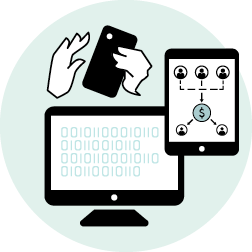In today’s digital age, the convenience of electronic payments has revolutionized the way businesses manage their financial transactions. While this shift has brought significant benefits, it has also opened the door to an array of complex payment-fraud schemes. This ever-persistent threat is a considerable risk, making adopting robust payment-fraud prevention strategies imperative.
In this article, we’ll discuss payment fraud, its prevalence in the U.S., and fraud-detection strategies that business owners, direct merchants, and financial managers can adopt to secure payment processing and mitigate fraud risks effectively.
What Is Fraud?
Fraud is a broad term that encompasses a variety of deceptions aimed at illicitly obtaining something of value, often involving financial or personal information. It includes phishing, pagejacking, identity theft, chargebacks, check fraud, merchant identity fraud, and card skimming, to name a few.
Payment fraud, in particular, is a prevalent form of fraud that revolves around false or illegal transactions. Typically initiated by cybercriminals, payment fraud involves the use of stolen credit card information to create counterfeit checks or initiate unauthorized electronic fund transfers.
Moreover, it may include claiming false refunds or initiating fraudulent return requests, all of which ultimately result in financial losses for businesses, as well as the theft of merchandise or services.
Fraud Statistics in the U.S.
In 2022, 2.4 million fraud reports were recorded through the Federal Trade Commission (FTC) database, with payment fraud resulting in a loss of approximately $1.6 billion. Checks continue to be the most vulnerable payment method in the U.S. According to a study by the Association for Financial Professionals (AFP), 63% of organizations reported attempted or actual check fraud.
Several factors in the U.S. contribute to the growing prevalence of fraud. First and foremost is the continued use of checks, an antiquated payment modality that exposes businesses to fraudulent activities.
Additionally, the rise in digital payments — accelerated by the COVID-19 pandemic — opened new avenues for cybercriminals to exploit. While convenient, many businesses rapidly shifted from in-person transactions to online without fully grasping the security risks, leaving gaps in security measures.
The concurrent economic challenges during the pandemic saw businesses, both large and small, become less vigilant in their pursuit of financial relief. Instead of protecting against payment fraud, many organizations inadvertently lowered their guard, failing to conduct due diligence and rigorous assessments before engaging in financial activities, opening the door to fraudulent transactions.
Fraud Detection Strategies
There are a number of effective payment-fraud prevention techniques that businesses can adopt to defend themselves from the ever-present threat of fraud and detect fraudulent transactions, including:
- Use Fraud-Prevention Tools
Utilize fraud-detection and prevention software specifically tailored to your business. These tools play a critical role in identifying and mitigating potential risks, ultimately safeguarding your financial assets and preserving your reputation.
Regularly verify the authenticity and accuracy of invoices by following these steps to prevent falling victim to invoice fraud:
- Designate specific individuals to be responsible for ordering supplies.
- Scrutinize all paperwork for discrepancies in account numbers and vendor contact information.
- Exercise caution when dealing with solicitations outside your normal business scope.
- Always confirm orders before authorizing payments.
- Check the security of websites.
Whenever conducting online transactions or sharing sensitive information, ensure the website is trustworthy. Keep an eye out for “https” in the URL and the presence of a lock icon in your browser’s address bar, which indicate a secure connection.
- Work with a Trusted Payment Processor
Established processors have robust security protocols, advanced fraud-detection systems, and a track record of safeguarding transactions. By choosing a trusted partner, you benefit from their expertise in identifying and preventing fraudulent activities, reducing the risk of unauthorized transactions, chargebacks, and data breaches.
Maintain a routine of reconciling your financial accounts. Regular reconciliation is the best payment-fraud prevention technique that can help you identify discrepancies and address issues promptly.
Continuously update your software and security measures. Keeping your systems and applications current is crucial for staying one step ahead of potential vulnerabilities that fraudsters might exploit.
The Importance of Reconciliation
Reconciliation is the process of meticulously comparing a company’s general ledger with bank statements to identify discrepancies such as math errors, outstanding checks, bank fees, and, most importantly of all, potential fraudulent transactions that may otherwise go unnoticed.
Regular reconciliation serves as a powerful early-warning system that can uncover inaccuracies and inconsistencies. In cases of suspected fraud, it can also provide a foundation for launching investigations. To successfully incorporate reconciliation into your finance-management practices, be sure to consider the following factors:
- Frequency of Reconciliation
The frequency of reconciliation should align with the specific needs and size of your business. Small businesses may perform reconciliation on a monthly basis, while larger enterprises might opt for weekly or even daily reconciliations. With this, also consider the volume and complexity of financial transactions for timely payment-fraud prevention.
The reconciliation process should be a structured and well-documented procedure that includes clear steps for identifying discrepancies and potential fraud indicators, reporting, and addressing.
- Manual vs. Automated Reconciliation
Manual reconciliation requires significant time and effort, which can lead to human errors. In contrast, automated reconciliation tools and software can reduce manual data entry, enhancing accuracy and efficiency. Additionally, these tools can flag potential discrepancies for closer inspection and provide an audit trail, making it easier to identify and address fraudulent transactions.
Protect Your Payments
The importance of payment-fraud prevention cannot be overstated. It is critical for protecting yourself and your business finances against criminal technology and tactics that get more sophisticated by the day. More than ever, it is vital to stay vigilant and adopt fraud-detection strategies — such as modern security tools, regular reconciliation, and partnering with a trusted payment processor like MerchantE — for comprehensive online payment-fraud prevention.
With over 20 years of experience and expertise, MerchantE is a reliable leader in secure payment-processing solutions, offering domestic, international, on-site, and online payment security.
Explore our website to learn more about our payment services and how we can protect your business’s finances.



